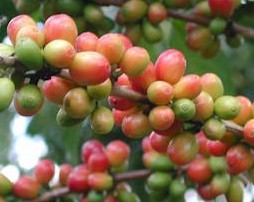Coffee – A Brief Historical Tour - Part One
Coffee – A Historical Tour
By
Roger X. Navas-Balladares
Part I
By
Roger X. Navas-Balladares
Part I

Coffee is native to Eastern Africa, and most experts agree it originated in what is now Central Ethiopia.
Legend has it that in the 800’s AD, an Ethiopian goatherd named Kaldi had lost some of his goat, and later found them frolicking around a dark green leafed shrub with bright red cherries. Kaldi tried a few of the bitter berries, and soon realized that it was these bright and learned of their powerful effect.
It is believed that a monk happened to see Kaldi and his goats jumping around and decided to take a few cherries back to his monastery. That night, the monks brew the cherries into an infusion and stayed awake until morning as if by “divine inspiration”. The world would never be the same.
According to The National Geographic’s website, other Africans of the same era may have used coffee beans to prepare a primitive form of “energy bar” by rolling animal fat and coffee beans; it is also believed that they used the coffee-berry to make wine.
Coffee as we know it is a product of the Arabian Peninsula, where it was first roasted around the year 1000 AD. During this time, the Kingdom of Yemen was it’s largest importer and consumer. It became a staple drink of Muslims community throughout the known world. Coffee houses sprouted all over the Muslim controlled Mediterranean and coffee became a valued export.
Arabia at this time exercised a tight monopoly of coffee beans. Because of the importance of coffee as commodity, it was illegal to export raw coffee beans. By edict, no coffee beans were allowed to leave the Arabian Peninsula without first being parched or boiled to prevent merchants from planting coffee beans elsewhere.
According to legend, in the 1600’s an Indian pilgrim to Mecca by the name of Baba Budan smuggled some green beans back to his homeland giving rise to a twisted and complicated agricultural staple loved and cherished by millions worldwide.
It is interesting to know that coffee is the second most exchanged commodity in the world, only another Middle East darling – Petroleum Oil surpasses it in volume. Most of the coffee grown today is grown in Latin American, Asian and parts of Africa, with Brazil, Colombia, Indonesia, Mexico and Vietnam being some of the largest producers. Keep in mind that though these countries produce a larger volume of the mass consumed coffee of the world, some of the best coffee comes from smaller producers such as Jamaica, Ethiopia, Nicaragua, Guatemala, Costa Rica, and Yemen to name a few.

<< Home